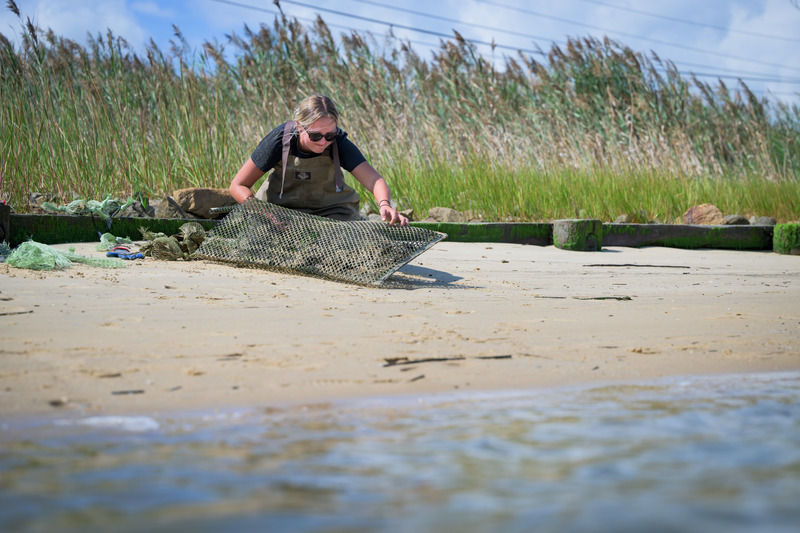
Category: News

Oysters and Living Shorelines
October 07, 2025 Written by Adam Thomas | Photo by Evan Krape
Living shorelines are a nature-based method of stabilizing shorelines using natural materials like oysters, plants, sand or rock.
These types of installations provide a suite of beneficial environmental services when compared to traditional shoreline armoring practices like installing bulkheads. Living shorelines that feature native plant and invertebrate species help provide habitat for those species that colonize the structures themselves, including Eastern Oyster, as well as juvenile fishes.
One way to ensure these shoreline installations are successful and expedite faunal succession is to outfit them with native oysters. A research team at the University of Delaware is exploring just that.
Rileigh Hudock, a master’s student in the College of Earth, Ocean and Environment, recently evaluated the growth and mortality of two strains of farmed oysters: NEH ®, high salinity tolerant oysters, and DBX, medium and low salinity tolerant oysters, to determine which species would perform better in the Delaware Bay at varying depths and locations within the estuary.
Hudock’s research was part of the Developing Engineering Practices for Ecosystem Design Solutions, or DEEDS project, funded through a Department of Defense appropriation.
At UD’s Hugh R. Sharp Campus in Lewes, Hudock worked with Ed Hale, assistant professor in the School of Marine Science and Policy and fisheries and aquaculture specialist with Delaware Sea Grant, and Brendan Campbell, research associate, on the project. She evaluated how the strain of an oyster, tidal position and environmental variables affect oyster growth and survival.
Working at the boat basin on the Sharp campus and Port Mahon in Dover, Hudock examined how the oysters would perform in different environments.
Hale said the two strains are “commonly used in oyster farming. We were kind of borrowing what we knew from the commercial production side to see if we could use it from a more practical, resilience-based application.”
Hudock found the NEH ® oysters, the strain with higher salinity tolerance, showed better meat condition and better general growth performance when compared to the DBX oysters, particularly in Lewes where they experience high salinity conditions.
The findings were recently published in the Frontiers in Ecology and Evolution scientific journal.
Hudock said while NEH ® work better in these high salinity environments, the recommendation would be for people who are building living shorelines to look for farmed oysters best suited to their local environments.
“Ultimately, you want to make your decision based on the available strains in the area and under what conditions those oyster strains grow best,” said Hudock. “Then we can make recommendations to help improve the efficiency of these installations because it is a slow and expensive process. If we can jump-start that development by putting in oysters that are best suited for that environment or place them in a tidal position that is better suited for that specific location, then we can optimize the installation for the future.”
Hudock explained another aspect of her master’s thesis is looking at wild recruitment data of oysters in the area.
Wild oysters found in the bay build reefs through recruitment, which is when natural oysters in the water column adhere to substrate during spawning events and form natural aggregations in the wild.
“I've been collecting oyster recruitment data for three years at these installation sites to see if living shorelines would be able to accrue oysters in these areas,” said Hudock.
Having oysters that can recruit is key, as they can lead to stable habitat for larvae and grow into a self-sustaining oyster reef.
“Oysters filter the water, stabilize the shoreline, and support the biodiversity of other animals. Over time, as we experience sea level rise, oysters will also rise with the water,” said Hudock. “Hard structures, like sea walls or breakwaters, will not change over time with the environment, but oysters have that ability. If the water is rising, then the reef will start to grow taller. Oysters are ecosystem engineers, and they provide a lot of ecosystem benefits.”




